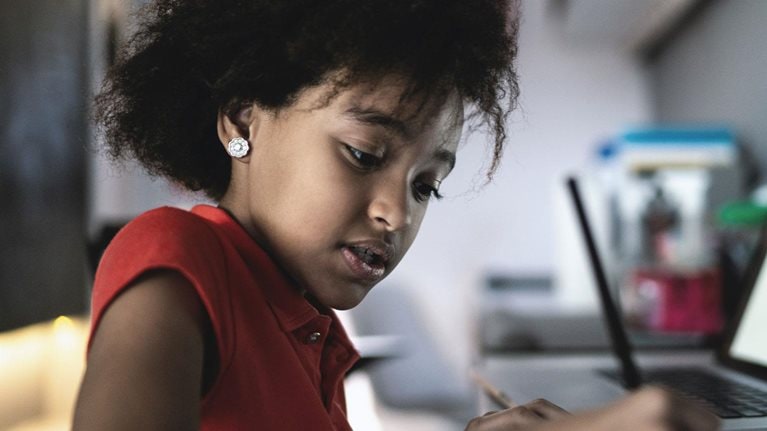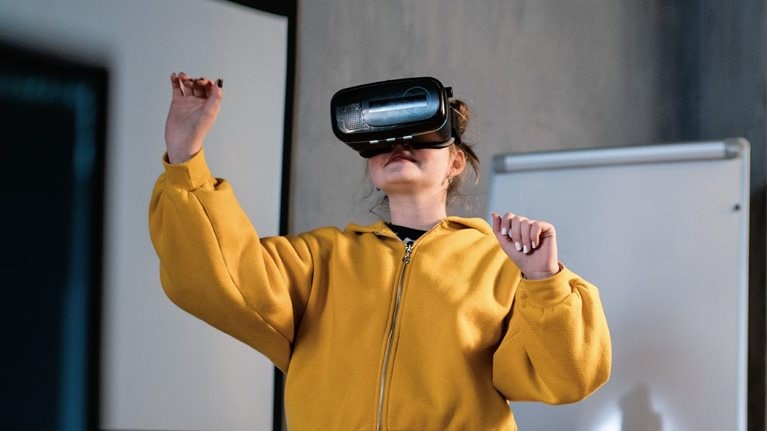Many countries in the region embracing the Middle East, North Africa, and Pakistan (MENAP) faced profound economic, political, and educational challenges even before the COVID-19 pandemic—for example, ongoing conflict in countries such as Iraq, Libya, Syria, and Yemen caused severe disruptions to the provision of education. COVID-19 further exacerbated the challenges facing the educational sector: about 100 million students in the Middle East, North Africa, and Pakistan couldn’t attend school in person for 4.5 to 14.0 months.1
But the pandemic also accelerated the shift to digital in education and spurred innovation and agility that made it possible for teaching to continue remotely, even in countries with a poor digital infrastructure. By building on the lessons of the past two years and leveraging educational technology beyond the pandemic, the region’s countries have an opportunity to close the gap, in both educational outcomes and digital literacy, between themselves and the rest of the world. In particular, sharing best practices and innovations among MENAP countries would help educational standards to rise across them.
The region’s current challenges include a failure to attain basic levels of education, bottom-level performance in international assessments, and the widespread lack of digital literacy.2 Our research has identified six key elements for overcoming these obstacles. If addressed, they could improve educational outcomes across the region.
The MENAP region currently trails in educational outcomes
Students in the Middle Eastern and North African countries that took part in the 2018 PISA3 test had scores some 20 percent lower than the average among the members of the Organisation for Economic Co-operation and Development (OECD). Half of all children in the MENAP region fail to reach a basic level of learning in primary school, compared with 37 percent in the world as a whole and 25 percent in the OECD countries.4 Differences in educational outcomes within the MENAP region reflect factors such as major differences in income among countries and ongoing school disruptions. The United Arab Emirates (UAE) is the only MENAP country where more than 60 percent of children reach a basic level of primary education. Lower numbers prevail in countries where challenges external to the educational system affect schools. In Yemen, for example, less than 10 percent of children achieve a basic level of learning in primary education (Exhibit 1).

According to UNICEF,5 most MENAP countries perform near the bottom in international assessments, such as PIRLS6 and TIMSS,7 and all countries in the region fall below the average. UNICEF suggests that traditional teacher-centered approaches, rote learning, and outdated curricula contribute to the shortcomings in the development of skills needed for lifelong learning and employability.8
The MENAP countries also lag behind others in digital literacy and in access to the internet. Internet penetration in the region has increased exponentially over the past two decades—from less than 5 percent in 2000 to more than 60 percent in 2020.9 However, it remains highly uneven across and within countries, ranging from over 100 percent in Qatar and the UAE to 44.7 percent in Pakistan and only 25.9 percent in Yemen.10 Within countries, vulnerable and lower-income people are less likely to use the internet, and that will probably increase the digital divide and exacerbate inequalities.11
On average, in MENAP countries that participated in the 2018 PISA survey, 70 percent of schools gave students access to the internet, a level below that of the OECD’s members and partners.12 Teachers in the region had access to fewer internet-linked computers at school, and fewer students had access to the internet and to a computer for schoolwork at home.13 A key issue that emerged in Pakistan in particular is that parents (and communities more generally) do not consider digital literacy a top priority.14
Unequal access and poor educational outcomes are further exacerbated in countries, such as Iraq, Lebanon, Syria, and Yemen, facing grave economic and political challenges. By the end of 2017, the number of unschooled children in the region increased to more than 14.3 million—a level last seen a decade before. In Iraq, Libya, Syria, and Yemen, upward of 8,850 educational facilities have been lost to conflicts.15
COVID-19 has disrupted the region’s educational landscape
The COVID-19 pandemic has not only intensified preexisting challenges and accelerated trends but also created the impetus for change. In the world as a whole, the number of children physically absent from school increased from 258.0 million in 2018 to 1.2 billion in 2020, including almost 100.0 million in the Middle East and North Africa.16 Every country in the region has been affected by the pandemic, to a greater or lesser extent, so many students cannot attend school, and some had limited or no access to live instruction during the lockdown phase.17 Since the pandemic’s start, schools in the region have been fully or partially closed for an average of more than ten months—ranging from 4.5 in Egypt to more than 14 in Iraq.18
Globally, the pandemic-era combination of school closures and loss of livelihoods could result in an average shortfall of 6.4 months, according to McKinsey’s latest research. In addition, the loss of time in school, compounded by additional regression in learning, could mean that grade-three children from low- and middle-income countries will have levels of learning one year lower than expected by the time they reach grade ten.19
Uneven digital literacy and uneven access to affordable, reliable internet connections and devices have further deepened inequities in educational outcomes. A McKinsey analysis in the United States has shown that students from vulnerable households are less likely to experience quality remote instruction. The result is an estimated loss of more than 12 months of learning—nearly double the average.20
But in the MENAP countries (as in others), the pandemic has also accelerated the digital shift in education. Saudi Arabia, for example, has implemented a well-crafted, technology-driven response. During the pandemic, the Ministry of Education (MoE) introduced and then scaled up several major e-learning platforms (including Madrasati for primary and secondary students and Rawdati for kindergarteners) while it ramped up efforts to give needy students access to devices.21 Initial user feedback suggests that both platforms have had significant benefits for students and teachers alike.
Even in countries with a limited digital infrastructure, the rapid shift to remote learning has accelerated the uptake of educational technologies that give vulnerable and remote populations access to education. Bahrain, Jordan, Lebanon, and Morocco have used TV channels to broadcast distance-learning content: the Alsama Project, for example, streams English-language lessons for children in Lebanese refugee camps. Jordan has also promoted the use of existing online platforms, such as Microsoft Teams and Edraak. Morocco and Oman have partnered with telecom companies to offer students free internet access on a wide variety of educational websites and online platforms.22
An opportunity to reimagine the region’s educational systems
COVID-19 has spurred the imagination and created the potential for change. People in the MENAP region now have an opportunity to rethink how its educational systems can shape the citizens of tomorrow.
Our research has identified six elements of success for a reimagined educational system: technology-enabled learning for every child; enhanced teacher quality to improve student outcomes; technology as an enabler of mastery-based, personalized learning; whole-child education; the creation of pathways for lifelong learning; and structural enablers to allocate resources equitably.
Technology-enabled learning for every child
Educational technology could improve access to quality education in the MENAP region, especially given its expanding penetration by the internet and smartphones. Tablets are now available for $35, which in some MENAP countries could put high-quality instruction directly in the hands of students and provide teachers with excellent, easy-to-follow lesson plans.
Governments could consider several ways of supporting tech-enabled instruction and better educational outcomes. To improve access to online resources, for example, education ministries could work with mobile operators to zero-rate educational websites, request that telecom providers shape bandwidth to prioritize education-related data and services, or consider lifting data caps on free internet access for students. Other moves that could support remote learning include enhancing the availability of voice-over-internet-protocol (VOIP) services, tapping universal-service funds, distributing more devices for home use (as Egypt did in response to school closures), and setting up free local Wi-Fi access points where students can upload work and download content.23
The UAE’s MoE has taken a number of steps to ensure the successful implementation of distance learning.24 Besides helping teachers to make the switch, the ministry established two advanced operations centers and facilitated a technical helpline for students and parents to ensure a smooth IT experience and effective communication between students and teachers. Families with no home internet connection received a free mobile-internet package, and the ministry also collaborated with Al Yah Satellite Communications to provide free satellite broadband services in areas lacking connectivity. Private schools were required to implement distance learning but allowed to use their own systems for that purpose.
Enhanced teacher quality to improve student outcomes
The importance of better teachers has been highlighted by school closures, which revealed variations in the quality of instruction.25 Technology cannot replace a great teacher, who may change a student’s life trajectory. However, it can reduce workloads and improve the quality of education through tech-enabled teacher training and development; simulation-based instruction, for example, is valuable and risk free. At the beginning of the pandemic, the UAE’s MoE conducted a one-week remote professional-training course for more than 25,000 government schoolteachers and administrators and more than 9,200 private-school teachers and principals. It also collaborated with Hamdan Bin Mohammed Smart University to launch a free online course about how to operate online classrooms.
Good teachers are critical to the performance and educational growth of students: on average, high-performing teachers can raise the performance of students by 53 percentage points over that of similar students with low-performing teachers.26 Teachers now work about 50 hours a week globally but spend only 20 to 40 percent of their time on instruction and engagement with students; the rest is devoted to administrative responsibilities, evaluation and feedback, preparation, and other nonteaching activities (Exhibit 2). As this workload continues to grow, technology could free up 20 to 30 percent of the time of teachers, allowing them to spend a greater proportion of the day engaging with students—which could improve educational outcomes. For example, AI and digital platforms could help to assess students (Exhibit 3).


Technology as an enabler of personalized, mastery-based learning
Several existing platforms, which already combine instruction and assessment with a variety of content and resources, provide real-time feedback to both students and teachers through data visualization dashboards. The use of these platforms could make it easier for schools to collect data, track educational outcomes, and intervene to correct course more frequently rather than rely on periodic standardized tests, such as PIRLS, PISA, and TIMSS, which are given every three years on average.
In the MENAP region, ministries of education have used existing platforms and created new ones in response to the pandemic. Jordan, for example, used MS Teams and Edraak (an Arabic-language open-access platform) for both K–12 and continuous learning. In March 2020, Morocco launched a new remote-learning platform, Telmid TICE, which 600,000 students access daily. In Qatar, Mzeed, accessible via website or app, was developed to help students and teachers access textbooks in PDF format and to provide model questions and answers, as well as other tools.27
Across the board, we found that providing information and communications technology (ICT) for teachers rather than students works best. However, a blended approach, combining teacher- and student-focused technologies, may have a still more beneficial impact.28 For example, teacher-focused technologies (such as data projection) promote maximum engagement between students and teachers and have been shown to raise PISA science scores. Giving students access to computers with internet connections (a student-focused approach) also improves scores by empowering students to work individually at school or at home. Increasing access to—and combining—these educational technologies could give students in the MENAP region a recipe for success.
Improving teacher-focused technologies tailored to the needs of individual students is critical to help them reach grade-level and subject standards. In a study on K–12 teachers in the region, 57 percent of those queried reported that the digital resources they received were not sufficient for their students to achieve appropriate educational standards.29 The study showed that the most acute needs for digital enhancement are in elementary-school science, elementary-school English-language arts, and middle-school social studies. It is expected that a 75 percent increase in the use of digital tools will be required to meet the future needs of the MENAP region’s students in a personalized way.
Whole-child education
An increasing amount of evidence suggests that teaching should focus on more than pure academics and instead foster a whole-child education.30 In fact, the biggest predictor of success for students in the region is mindset: the 2018 PISA survey determined that a motivated mindset was twice as important as an orientation to the subject matter for PISA science scores. Mindset comprises five dimensions: motivation calibration, the ability to identify what motivation means in day-to-day life; motivation, the desire to succeed and receive good grades; instrumental motivation, how useful the subject will be for future lives and careers; a sense of belonging, how accepted the learner feels in school; and test anxiety, how anxious the learner is when taking a test.
Motivation calibration was shown to be the factor contributing most to success (Exhibit 4): for example, students with good motivation calibration scored, on average, 14 percent higher on PISA than those with poor motivation calibration, and low-income students with higher motivation calibration were more likely to succeed than low-income students with poor motivation calibration.

An educational system could therefore consider using a broader approach, going beyond the traditional acquisition of skills to encompass empowering mindsets. This goal will require competency frameworks to strengthen values and attitudes across the curriculum, a focus on future skills, and a reduced emphasis on technical competencies (given automation trends and the rapid obsolescence of knowledge).
Creating pathways for lifelong learning
Rapidly accelerated shifts in degree offerings and delivery models mean that lifelong learning no longer starts in higher education: rather, it is a muscle that can be developed by high-school students, who can look beyond their brick-and-mortar schools for certifications.
The trend of preparing students for lifelong learning, especially in coding and digital literacy, has been accelerating globally. The MENAP region has a few best-practice cases. For instance, INJAZ Al-Arab, a nongovernmental organization (NGO) that targets youth workforce readiness, financial literacy, and entrepreneurship, partners with 92,905 volunteers, 4,000 schools, 426 universities, and 13 ministries of education across the region. It has helped more than 4.4 million students to bridge the gap between education and the labor force.31 In Lebanon, the nonprofit CodeBrave works with schools and NGOs to empower students from disadvantaged backgrounds, including refugees, by teaching them to teach themselves and solve problems, as well as digital literacy.32
Structural enablers to allocate resources equitably
The MENAP countries could help unleash the potential of technology in the classroom by considering changes to policies and regulatory frameworks. Governments can, for example, use performance-based funding to align quality with resources and empower all children. They could also engage the private sector, which has the resources to deliver quality education efficiently at the scale required to meet growing demand. In fact, governments might consider shifting their role from operators to enablers and regulators, using targeted funding to ensure access for underprivileged students.
Finally, as educational systems shift from skills-based to values- and attitudes-based learning, parental engagement will become increasingly important. During the pandemic, Qatar and the UAE provided parents with guidelines and advice to help them fulfill their new role of supporting their children’s remote learning at home.33 In Bahrain and Jordan, schools mostly used WhatsApp and Facebook to communicate with parents and update them about their children’s progress.34
The time to reimagine and shape the future of education in the MENAP region is now—and this has never seemed more urgent. As the social and economic toll of the COVID-19 crisis continues to unfold, innovative and timely investments in the region’s human capital are the surest way to help countries weather the crisis and prepare for a rapidly changing world. We see four broad actions to establish a new lifelong-learning model that would prepare the populations of the MENAP region for the future of work.
- Invest smartly in educational technology to improve digital literacy and support teachers inside and outside the classroom.
- Adopt holistic education frameworks that focus on values, mindsets, skills, and competencies.
- Embed lifelong learning—especially in basic technological literacy, workforce readiness, and cognitive skills—across the education journey.
- Engage the private sector effectively to enhance the efficiency, delivery, and relevance of education.
These imperatives will require the mobilization of parents, students, teachers, school leaders, governments, and employers. Meanwhile, educational institutions will need to find new ways of fixing the old path and charting new paths and solutions to reimagine education going forward.


